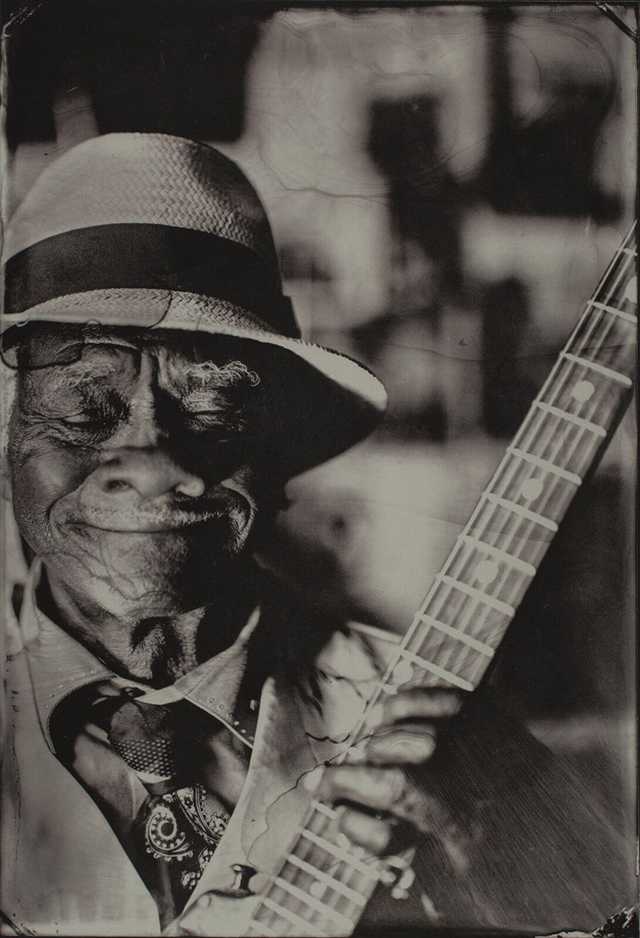
Cool John Ferguson and Captain Luke, who created a genre of music they call “Outsider Lounge,” in Guitar Heaven, Hillsboro, NC.
The Music Maker Relief Foundation “wasn’t started with a grand scheme,” said Tim Duffy, but with a small group of musicians in Winston-Salem, North Carolina, with whom he’d developed relationships.
“I remember thinking I was doing really good to book someone on a gig; and then I arrived at their house to go to the show, and the musician’s frantic, trying to gather money or pawn something to get high blood pressure medicine for his wife,” Duffy said. “There, I realized that a lot of these musicians are living on $4,000–5,000 [a year], and there were other issues that had to be addressed to deal with this correctly.”
The roots of blues music run deep in the South. The genre can be traced back to the late 1800s, when it was born from traditional African American music and evolved into the soulful, honest, and musically distinctive sound now recognized around the world. The forefathers (and mothers) of the iconic genre are regarded as legends for their role in creating a seminal piece of American culture, so why did Duffy find so many of them living in abject poverty?
This is the issue that inspired the North Carolina-based folklorist to launch the Music Maker Relief Foundation, a nonprofit organization dedicated not only to preserving blues music but also to helping sustain many of America’s now-elderly blues musicians. Duffy and the foundation have worked with nearly four hundred artists since setting out in 1994, including Little Freddie King, Pat “Mother Blues” Cohen, and Ironing Board Sam. These and the other hundreds of musicians supported by Music Maker are not necessarily household names, which is why the foundation plays a vital role in promoting and preserving their music.

TIM DUFFY
Little Freddie King, a Music Maker musician who moved to New Orleans at fourteen and has performed at every Jazz and Heritage Festival.
Music Maker not only provides financial support but also career development by way of promoting and booking shows for the musicians. Duffy has also established the Music Maker label, to record musicians who work with the foundation. Music Maker has released close to 175 records, but Duffy said that recording blues albums is more about preserving the music and contributing to the musicians’ communities than raising money.
“There’s no money in it,” Duffy said. “It’s really to document who we are. And their voices are great, and the music’s fantastic; but it doesn’t fit in the record-business model because it never would sell enough. But we do it, and we find that great change in small communities can come from it.”
Pat “Mother Blues” Cohen on Bourbon Street in New Orleans, where she made her living as a singer and entertainer before Hurricane Katrina destroyed her home in the 9th Ward.
Many of the musicians Duffy and the foundation assist are Louisiana locals who’ve been impacted by natural disasters, like Hurricane Katrina or the Baton Rouge-area flooding that took place in August 2016. One such musician is Baton Rouge-based piano player Henry Gray, who at 92 years old is unable to support himself solely playing music. Thanks to the Music Maker Relief Foundation, Gray receives $200 a month to help make ends meet.
“That’s the kind of program we do because it wasn’t going to work to sign and sell records or tour someone that’s 90 years old to make money,” Duffy said. “And they’ve given so much, why can’t we give back to the people who have given us so much?”
After helping more than three hundred artists over twenty years, Duffy thought of another idea that could help support these musicians and preserve their legacy: portraits. “I used to play guitar with the guys a lot and have been taking pictures all along,” Duffy said. He realized that exhibiting portraits of these musicians was an effective way to bring attention to those who have, over time, slipped out of the modest limelight that a career as a rural blues musician provides.
Duffy wanted to use a medium that echoed the timeless quality of the musicians he was photographing, so he learned how to shoot using a process called wet-plate collodion, a historic photography method in which images are developed directly onto a thin piece of metal known as a tintype.
“I chose tintype because, though I had to learn how to do it, it questions time in a way where you don’t know if that picture is a hundred years old or taken last year or last month,” Duffy said. “And it questions the birth of the music and the beginnings of photography and the beginnings of the blues, or relatively. They’re all very old traditions.”
[Read this: A Music-Heritage Road Trip: A detailed driving guide links the South’s music capitals.]Though tintypes seemed perfectly suited for depicting these blues musicians, the medium posed a problem when it came to exhibiting because there are no negatives involved, so it is difficult for them to yield prints. Eventually, with the help of publisher Steven Albahari, Duffy was able to make prints of the portraits that were even richer and more vivid than the original tintypes using a process called platinum palladium printing.
According to Duffy, platinum palladium printing is not only aesthetically beautiful but also one of the longest-lasting types of print. “And I said, well, that would be the way to present these guys. Because color fades. This won’t fade. These, someone will dig up and pull out of an archive two hundred years from now,” Duffy said.
Not only have the prints given Duffy’s photographs a striking depth of tone and dimension, they have allowed for the portraits to be exhibited in venues across the country. The exhibit, titled Our Living Past, came to Louisiana for the first time this year. It’s currently on display at the Alexandria Museum of Art until May 27, with the closing weekend coinciding with the Little Walter Music Festival in Alexandria.
“The charisma and emotion that comes through in many of these portraits is somewhat contagious, and the work is very interesting,” said Megan Valentine, curator at the Alexandria Museum of Art.
“THAT’S THE KIND OF PROGRAM WE DO BECAUSE IT WASN’T GOING TO WORK TO SIGN AND SELL RECORDS OR TOUR SOMEONE THAT’S 90 YEARS OLD TO MAKE MONEY,” DUFFY SAID. “AND THEY’VE GIVEN SO MUCH, WHY CAN’T WE GIVE BACK TO THE PEOPLE WHO HAVE GIVEN US SO MUCH?”
Duffy said that this is “just the beginning” of the Our Living Past exhibit and the work Music Maker is doing to preserve the legacies of the musicians. “This [exhibit] will be on tour for decades to follow. It’s gonna keep growing,” Duffy said. “And this is a brand new chapter of what Music Maker is doing—to embark on solidifying these unknown musicians as great known musicians. The faces on the wall are not B.B. King and Eric Clapton and Bon Jovi. These are regular, working class folks that are unsung heroes.”
And until these blues musicians receive their due praise, Duffy will continue photographing, recording, befriending, and assisting them through the Music Maker Relief Foundation. “That’s the greatest thing about these artists: They carry these archaic traditions for a reason, ‘cause they love them. And so, maybe other musical traditions and pop styles have changed along the way, but they’ve chosen to keep something beautiful of their culture alive,” Duffy said. “And we try to jump in and help them keep it alive ‘cause it’s important.”
For more information on Our Living Past, on Tim Duffy and the blues musicians he works with, or to make a donation, visit musicmaker.org.









